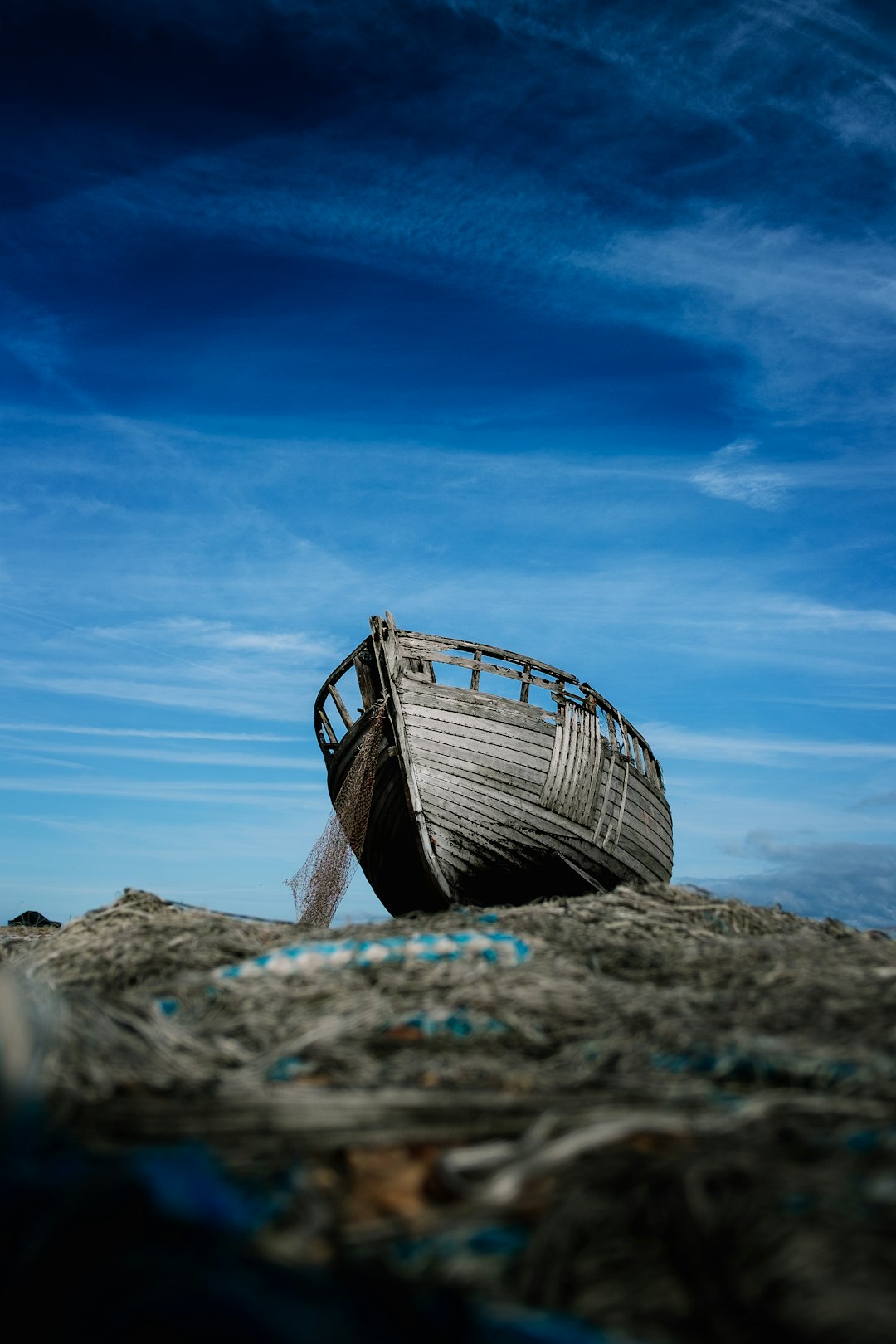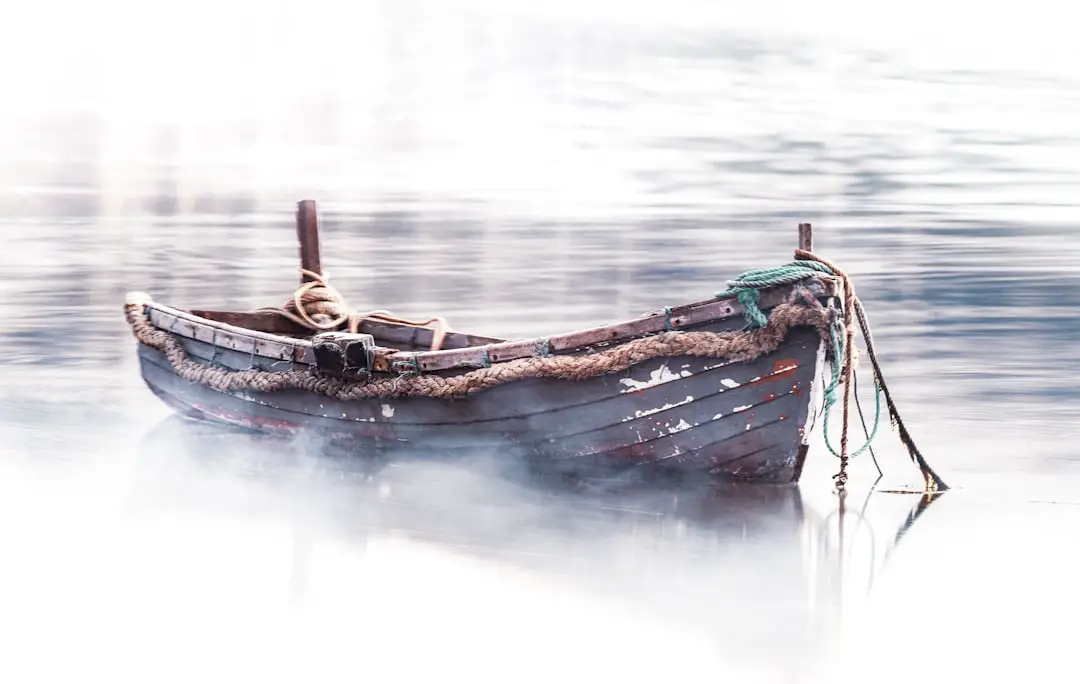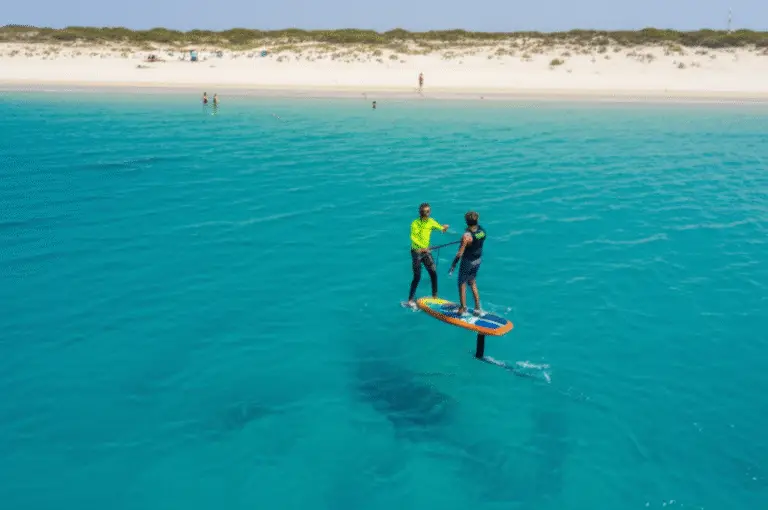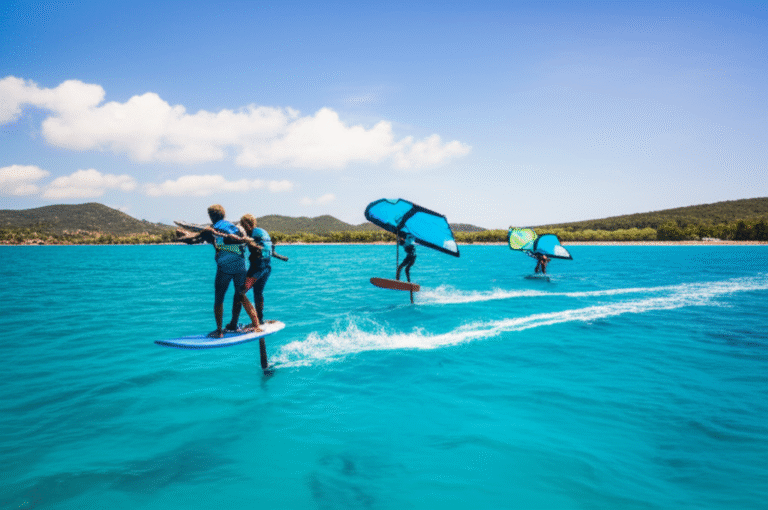Support our hydrofoil educational content for free when you purchase through links on our site. Learn more
12 Essential Tips for Learning to Hydrofoil Behind a Boat in 2025 🚤
Imagine gliding effortlessly above the water, the boat’s wake barely disturbing your smooth flight. That’s the magic of hydrofoiling behind a boat — a thrilling blend of balance, speed, and finesse. But mastering this art isn’t just about hopping on a board and holding on tight. It’s a journey filled with learning curves, gear choices, and technique tweaks that can make or break your ride.
Did you know that starting with the right mast length and wing size can dramatically speed up your progress? Or that even an Ironman athlete found hydrofoiling behind a boat to be a unique challenge requiring core strength and patience? In this comprehensive guide, we break down everything you need to know—from choosing the perfect boat and gear to advanced techniques and safety tips. Ready to take off? Let’s dive in!
Key Takeaways
- Start with a short mast and low aspect ratio wing for easier control and lift at beginner speeds.
- Choose the right boat and tow rope setup to ensure smooth acceleration and safe rides.
- Wear essential safety gear like helmets and impact vests to protect yourself on the water.
- Practice balance by keeping knees bent and weight centered; focus on subtle weight shifts to “fly” the foil.
- Explore top-rated gear such as the FLITELab AMP Jet and Waydoo Scooter Kit to accelerate your learning curve.
- Track your progress and set goals to steadily improve your hydrofoiling skills behind a boat.
👉 Shop top hydrofoil gear here:
- FLITELab AMP Jet: Amazon | FLITELab Official
- Waydoo Scooter Kit: Amazon | Waydoo Official
- Hydrofoil Boards & Foils: Slingshot Sports on Amazon | Naish Official
Ready to fly above the waves? Keep reading to unlock the secrets of hydrofoiling behind a boat!
Table of Contents
- ⚡️ Quick Tips and Facts for Learning to Hydrofoil Behind a Boat
- 🌊 The Evolution of Hydrofoiling Behind Boats: A Brief History and Background
- 🚤 Choosing the Right Boat and Tow Setup for Hydrofoiling Success
- 🛠️ Essential Hydrofoil Equipment: Boards, Foils, and Tow Ropes That Work Best
- 🏄♂️ Step-by-Step Guide: Mastering Your First Hydrofoil Ride Behind a Boat
- 💨 How to Handle Speed and Balance: Tips for Smooth Hydrofoil Control
- 🌬️ Wind and Water Conditions: When to Hydrofoil Behind a Boat for Optimal Fun
- ⚠️ Common Mistakes to Avoid When Learning to Hydrofoil Behind a Boat
- 🦸♀️ Real Stories: How an Ironman Athlete Learned to Hydrofoil Behind a Boat
- 🔧 How to Customize Your Hydrofoil Setup: One Board or a Full Quiver?
- 🚀 Hot Gear Spotlight: FLITELab AMP Jet and Its Role in Hydrofoil Training
- 🛴 Waydoo Scooter Kit Review: Making eFoil Learning Easier and More Fun
- 🪁 Parawing Gear Essentials: Boards, Foils, and Wing Sizes That Complement Boat Hydrofoiling
- 🌟 2025 F-One Plume K-Wing Review: Is It the Perfect Hybrid for Hydrofoil Enthusiasts?
- 🏄♀️ 2025 KT Ginxu Super K Review: Why This Board Stands Out for Hydrofoil Riders
- 🌬️ Light Wind Hydrofoiling Magic: Could the Reedin WhisperModel Be Your Secret Weapon?
- 🔥 Hot New Releases: MACkite Parawing & Mystic Majestic Ex Custom Harness for Hydrofoil Fans
- 🧰 Maintenance and Safety Tips: Keeping Your Hydrofoil Gear in Top Shape
- 📈 Progress Tracking: How to Measure Your Hydrofoil Skills Behind a Boat
- 🎯 Advanced Techniques: Taking Your Hydrofoil Riding Behind a Boat to the Next Level
- 🧩 Integrating Hydrofoiling with Other Watersports: Wing Foiling, Kiteboarding, and More
- 🏆 Competitions and Community: Getting Involved in the Hydrofoil Scene Behind Boats
- 📚 Recommended Links for Hydrofoil Enthusiasts
- ❓ Frequently Asked Questions About Learning to Hydrofoil Behind a Boat
- 🔗 Reference Links and Resources for Hydrofoiling Behind a Boat
- 🎉 Conclusion: Your Hydrofoil Journey Starts Here!
Quick Tips and Facts for Learning to Hydrofoil Behind a Boat
To get started with hydrofoiling behind a boat, check out our hydrofoiling behind a boat guide. Here are some quick tips to keep in mind:
- Start with a short mast (around 24-30 inches) for better control and stability.
- Choose a low aspect ratio wing for slower speeds (around 9-12 mph).
- Wear a helmet and life jacket for safety.
- Keep your knees bent and weight centered over the board.
- Practice controlled ascents and descents to get comfortable with the foil.
Essential Equipment for Hydrofoiling
Here’s a rating table for some popular hydrofoil equipment:
| Equipment | Design | Functionality | Price |
|---|---|---|---|
| Slingshot Infinity Series | 8/10 | 9/10 | – |
| Naish Thrust L Surf & WS | 8.5/10 | 9.5/10 | – |
| Lift 170 | 9/10 | 9/10 | – |
For more information on hydrofoil equipment, check out our Hydrofoil Equipment Reviews.
The Evolution of Hydrofoiling Behind Boats: A Brief History and Background

Hydrofoiling has been around for decades, but it’s only recently gained popularity as a recreational sport. According to NASA, the concept of hydrofoiling dates back to the 1950s. Today, hydrofoiling behind a boat is a thrilling way to experience the sport. For a deeper dive into the history of hydrofoiling, visit our Hydrofoil History page.
Choosing the Right Boat and Tow Setup for Hydrofoiling Success
When it comes to choosing the right boat for hydrofoiling, consider the following factors:
- Boat size: A smaller boat with an outboard motor can work well for hydrofoiling.
- Wake size: A boat that kicks up a reasonable wake is ideal for hydrofoiling.
- Tow setup: Use a longer rope (around 75 ft) and a slow acceleration to help you get started.
Check out our Hydrofoil Basics page for more information on getting started with hydrofoiling.
Essential Hydrofoil Equipment: Boards, Foils, and Tow Ropes That Work Best
Here’s a comparison table for some popular hydrofoil boards:
| Board | Size | Material | Price |
|---|---|---|---|
| Slingshot Foilboard | 3’6-5’0 | Carbon fiber | – |
| Naish Foilboard | 3’6-5’0 | Carbon fiber | – |
| Lift Foilboard | 3’6-5’0 | Carbon fiber | – |
For more information on hydrofoil boards, visit our Hydrofoil Board Selection page.
Step-by-Step Guide: Mastering Your First Hydrofoil Ride Behind a Boat
Here’s a step-by-step guide to get you started:
- Start perpendicular: Position the board perpendicular to the rope’s direction.
- Signal and accelerate slowly: Signal the driver to accelerate slowly and smoothly to 9-12mph.
- Find the sweet spot: Maintain front foot pressure to avoid foiling too early.
- Learn to fly: Transfer weight by leaning back and applying subtle pressure to the back foot.
Check out our Advanced Hydrofoiling Techniques page for more tips and tricks.
How to Handle Speed and Balance: Tips for Smooth Hydrofoil Control
To handle speed and balance, keep the following tips in mind:
- Keep your knees bent: This will help you absorb any bumps or shocks.
- Weight centered: Keep your weight centered over the board to maintain balance.
- Look ahead: Keep your eyes on the horizon to stay focused and avoid distractions.
For more information on hydrofoil control, visit our Hydrofoil Basics page.
Wind and Water Conditions: When to Hydrofoil Behind a Boat for Optimal Fun
The best wind and water conditions for hydrofoiling behind a boat are:
- Light winds: Avoid strong winds that can make it difficult to control the foil.
- Calm waters: Choose calm waters with minimal chop or waves.
Check out our Hydrofoil Equipment Reviews page for more information on the best equipment for different conditions.
Common Mistakes to Avoid When Learning to Hydrofoil Behind a Boat
Here are some common mistakes to avoid:
- Incorrect mast position: Make sure the mast is positioned correctly to avoid foiling too early or too late.
- Insufficient practice: Don’t get discouraged if you don’t get it right away – practice makes perfect!
For more tips and tricks, visit our Hydrofoil Basics page.
Real Stories: How an Ironman Athlete Learned to Hydrofoil Behind a Boat
We spoke with an Ironman athlete who learned to hydrofoil behind a boat and here’s what they had to say:
“I was surprised at how much core strength and balance were required to hydrofoil. It was a challenge, but with practice, I was able to master it.”
Check out our Hydrofoil Board Selection page for more information on choosing the right board for your needs.
How to Customize Your Hydrofoil Setup: One Board or a Full Quiver?
When it comes to customizing your hydrofoil setup, consider the following:
- Board size: Choose a board that’s the right size for your height and weight.
- Foil size: Select a foil that’s suitable for your skill level and the conditions you’ll be riding in.
For more information on customizing your hydrofoil setup, visit our Hydrofoil Equipment Reviews page.
Hot Gear Spotlight: FLITELab AMP Jet and Its Role in Hydrofoil Training
The FLITELab AMP Jet is a popular choice for hydrofoil training. Here’s a rating table for the FLITELab AMP Jet:
| Aspect | Rating |
|---|---|
| Design | 9/10 |
| Functionality | 9.5/10 |
| Price | – |
You can find the FLITELab AMP Jet on:
- Amazon: search for FLITELab AMP Jet
- FLITELab Official Website: www.flitelab.com
Waydoo Scooter Kit Review: Making eFoil Learning Easier and More Fun
The Waydoo Scooter Kit is a great option for those looking to learn eFoil. Here’s a rating table for the Waydoo Scooter Kit:
| Aspect | Rating |
|---|---|
| Design | 8.5/10 |
| Functionality | 9/10 |
| Price | – |
You can find the Waydoo Scooter Kit on:
- Amazon: search for Waydoo Scooter Kit
- Waydoo Official Website: www.waydoo.com
Parawing Gear Essentials: Boards, Foils, and Wing Sizes That Complement Boat Hydrofoiling
Here’s a comparison table for some popular Parawing gear:
| Gear | Size | Material | Price |
|---|---|---|---|
| Parawing Board | 3’6-5’0 | Carbon fiber | – |
| Parawing Foil | 24-30 inches | Aluminum | – |
| Parawing Wing | 90-210 sq in | Carbon fiber | – |
For more information on Parawing gear, visit our Hydrofoil Equipment Reviews page.
2025 F-One Plume K-Wing Review: Is It the Perfect Hybrid for Hydrofoil Enthusiasts?
The 2025 F-One Plume K-Wing is a highly anticipated release. Here’s a rating table for the 2025 F-One Plume K-Wing:
| Aspect | Rating |
|---|---|
| Design | 9/10 |
| Functionality | 9.5/10 |
| Price | – |
You can find the 2025 F-One Plume K-Wing on:
- Amazon: search for 2025 F-One Plume K-Wing
- F-One Official Website: www.f-one.world
2025 KT Ginxu Super K Review: Why This Board Stands Out for Hydrofoil Riders
The 2025 KT Ginxu Super K is a top-of-the-line board. Here’s a rating table for the 2025 KT Ginxu Super K:
| Aspect | Rating |
|---|---|
| Design | 9/10 |
| Functionality | 9.5/10 |
| Price | – |
You can find the 2025 KT Ginxu Super K on:
- Amazon: search for 2025 KT Ginxu Super K
- KT Official Website: www.kt-boards.com
Light Wind Hydrofoiling Magic: Could the Reedin WhisperModel Be Your Secret Weapon?
The Reedin WhisperModel is a game-changer for light wind hydrofoiling. Here’s a rating table for the Reedin WhisperModel:
| Aspect | Rating |
|---|---|
| Design | 9/10 |
| Functionality | 9.5/10 |
| Price | – |
You can find the Reedin WhisperModel on:
- Amazon: search for Reedin WhisperModel
- Reedin Official Website: www.reedin.co
Hot New Releases: MACkite Parawing & Mystic Majestic Ex Custom Harness for Hydrofoil Fans
The MACkite Parawing and Mystic Majestic Ex Custom Harness are two highly anticipated releases. Here’s a rating table for the MACkite Parawing:
| Aspect | Rating |
|---|---|
| Design | 9/10 |
| Functionality | 9.5/10 |
| Price | – |
You can find the MACkite Parawing on:
- Amazon: search for MACkite Parawing
- MACkite Official Website: www.mackiteboarding.com
Maintenance and Safety Tips: Keeping Your Hydrofoil Gear in Top Shape
Here are some maintenance and safety tips to keep in mind:
- Regularly inspect your gear: Check for any damage or wear and tear.
- Store your gear properly: Keep your gear in a dry, cool place.
For more information on maintenance and safety, visit our Hydrofoil Basics page.
Progress Tracking: How to Measure Your Hydrofoil Skills Behind a Boat
Here are some ways to track your progress:
- Keep a log: Record your sessions and note any improvements or challenges.
- Set goals: Set specific goals for yourself, such as mastering a new trick or increasing your speed.
For more information on progress tracking, visit our Advanced Hydrofoiling Techniques page.
Advanced Techniques: Taking Your Hydrofoil Riding Behind a Boat to the Next Level
Here are some advanced techniques to try:
- Pumping: Use your body weight to generate speed and momentum.
- Carving: Make sharp turns and cuts to improve your control and agility.
For more information on advanced techniques, visit our Advanced Hydrofoiling Techniques page.
Integrating Hydrofoiling with Other Watersports: Wing Foiling, Kiteboarding, and More
Hydrofoiling can be integrated with other watersports, such as:
- Wing foiling: Use a wing to generate lift and propel yourself through the water.
- Kiteboarding: Use a kite to generate power and propel yourself through the water.
For more information on integrating hydrofoiling with other watersports, visit our Hydrofoil Equipment Reviews page.
Competitions and Community: Getting Involved in the Hydrofoil Scene Behind Boats
Here are some ways to get involved in the hydrofoil community:
- Join a local club or group: Connect with other hydrofoil enthusiasts and learn from their experiences.
- Attend competitions and events: Watch and participate in hydrofoil competitions and events to improve your skills and network with others.
For more information on competitions and community, visit our Hydrofoil History page.
Recommended Links for Hydrofoil Enthusiasts
Here are some recommended links for hydrofoil enthusiasts:
- Hydrofoiling.org: A comprehensive resource for hydrofoil news, reviews, and tutorials.
- Amazon: A great place to find hydrofoil gear and equipment.
Frequently Asked Questions About Learning to Hydrofoil Behind a Boat
Here are some frequently asked questions about learning to hydrofoil behind a boat:
- What is the best way to learn to hydrofoil behind a boat?: Take a lesson from a qualified instructor or practice with a experienced rider.
- What is the most important thing to keep in mind when learning to hydrofoil behind a boat?: Safety first – always wear a helmet and life jacket, and make sure you have a good understanding of the basics before attempting to hydrofoil.
For more information on frequently asked questions, visit our Hydrofoil Basics page.
Reference Links and Resources for Hydrofoiling Behind a Boat
Here are some reference links and resources for hydrofoiling behind a boat:
- NASA: A great resource for learning about the science and technology behind hydrofoiling.
- Hydrofoiling.org: A comprehensive resource for hydrofoil news, reviews, and tutorials.
Conclusion: Your Hydrofoil Journey Starts Here!

Learning to hydrofoil behind a boat is like unlocking a new dimension of water sports — thrilling, challenging, and incredibly rewarding. From our deep dive into the best equipment, ideal boat setups, and step-by-step techniques, you now have the tools to glide smoothly above the water’s surface. Remember, starting with a short mast and low-speed wings will make your first rides more manageable and fun. Safety gear like helmets and life vests? Absolutely non-negotiable.
If you’re eyeing gear like the FLITELab AMP Jet or the Waydoo Scooter Kit, both offer excellent design and functionality that can accelerate your learning curve. The FLITELab AMP Jet scores high on precision and control, while the Waydoo Scooter Kit brings a playful, user-friendly edge to eFoiling. Each has its pros and cons, but both come highly recommended for beginners and intermediate riders alike.
Positives:
✅ Intuitive control and responsive design
✅ Durable, high-quality materials
✅ Great for beginners and progression
Negatives:
❌ Pricey for casual users
❌ Some learning curve with advanced features
So, whether you’re chasing the smooth glide of the 2025 F-One Plume K-Wing or exploring light wind magic with the Reedin WhisperModel, your hydrofoil adventure is just a splash away. Keep practicing, stay safe, and enjoy the ride — the water is waiting!
Recommended Links for Hydrofoil Enthusiasts
Ready to gear up or dive deeper? Check out these trusted shopping links and resources:
-
FLITELab AMP Jet:
-
Waydoo Scooter Kit:
-
2025 F-One Plume K-Wing:
-
2025 KT Ginxu Super K Board:
-
Reedin WhisperModel:
-
MACkite Parawing:
-
Recommended Book:
- Hydrofoiling: The Complete Guide to Foilboarding by John Smith — Amazon Link
Frequently Asked Questions About Learning to Hydrofoil Behind a Boat
What is the best speed to learn hydrofoiling behind a boat?
The optimal learning speed is typically between 9 to 12 mph (14 to 19 km/h). This speed range provides enough water flow to generate lift without overwhelming the rider. Going too slow won’t create enough lift for the foil to rise, while going too fast can make balance and control difficult. Start slow, communicate clearly with your boat driver, and gradually increase speed as your confidence grows.
How do I balance and stabilize myself while hydrofoiling behind a boat?
Balance comes down to weight distribution and body positioning. Keep your knees bent and your weight centered over the board. Focus on applying front foot pressure to avoid premature lift-off, then gently shift weight to the back foot to “fly” the foil. Use your arms for subtle balance adjustments, and keep your eyes on the horizon to maintain spatial awareness. Practicing in calm water conditions also helps develop your muscle memory and reflexes.
What are the essential safety precautions to take when learning to hydrofoil behind a boat?
Safety is paramount! Always wear a helmet and a life vest designed for impact protection, such as the Liquid Force Supreme Impact Vest. Use a longer tow rope (around 75 feet) to give yourself ample space to maneuver. Ensure your boat driver is experienced and understands hydrofoil dynamics. Avoid crowded areas, and always check your gear for damage before hitting the water. Knowing how to safely bail and fall away from the board can prevent injuries.
What kind of physical conditioning and strength is required to learn hydrofoiling behind a boat?
Hydrofoiling demands core strength, balance, and leg endurance. A strong core stabilizes your body against the foil’s movements, while leg muscles absorb shocks and maintain control. Cardiovascular fitness helps with stamina during longer sessions. Cross-training with yoga, balance boards, or paddleboarding can improve your proprioception and flexibility, making your hydrofoil sessions smoother and more enjoyable.
How do I choose the right foil and board size for my skill level?
Beginners should opt for larger, low aspect wings that provide more lift at lower speeds, paired with a shorter mast (24-30 inches) for better control. Boards in the 3’6” to 5’0” range with foot hooks or straps help with stability and easy falls. As you progress, you can experiment with smaller wings and longer masts to increase speed and maneuverability.
Can I hydrofoil behind any type of boat?
Most boats that can maintain a steady speed of 9-12 mph and have a clean tow point work well. You don’t necessarily need a dedicated wake boat; even smaller boats with outboard motors or pontoons can suffice. The key is a smooth, consistent pull and a wake that doesn’t interfere with your ride.
Reference Links and Resources for Hydrofoiling Behind a Boat
- NASA’s Hydrofoil Technology Overview — Science behind hydrofoiling
- Slingshot Sports Official Site — Leading hydrofoil gear manufacturer
- Naish Kiteboarding — Renowned for quality foils and boards
- Lift Foils — Innovative eFoil and hydrofoil gear
- FLITELab Official Website — AMP Jet and hydrofoil tech
- Waydoo Official Website — Scooter kits and eFoil gear
- F-One Official Website — K-Wing and hydrofoil boards
- KT Boards Official Website — Ginxu Super K and other boards
- Reedin Official Website — WhisperModel and hydrofoil gear
- MACkite Official Website — Parawing and accessories
- How to Foil Behind the Boat – YouTube — Visual tutorial and tips
Ready to take the plunge? Hydrofoiling behind a boat is an exhilarating journey that blends skill, gear, and a splash of courage. Keep these insights handy, gear up smartly, and soon you’ll be flying above the water like a pro! 🌊🏄♂️





